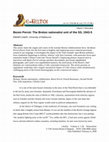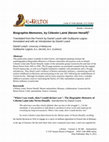Books by Daniel Leach

Four Courts Press, Dublin, 2009
From 1937 to 1950 the Irish government granted political asylum to a number of European minority ... more From 1937 to 1950 the Irish government granted political asylum to a number of European minority nationalists, many of whom were wanted for crimes of collaboration with Axis forces during the Second World War. Although inspired by the Irish struggle for independence, they came discreetly and their hosts sought largely to conceal their presence. Bretons, Basques, Scots, Flemings – even a high-ranking Croat later dubbed the ‘Yugoslav Himmler’ – all found temporary or permanent refuge in Ireland.
Fugitive Ireland reveals for the first time why Dublin sheltered foreign militants who had so disastrously regarded Nazi invasion as their nationalist ‘opportunity.’ Employing unpublished sources and personal accounts, Daniel Leach explores the role of political asylum in asserting Irish sovereignty, Catholic anti-communism and revolutionary heritage, and exposes a previously hidden and controversial chapter of Irish and European history – one which, through the continued actions of post-war and even modern exiles, continues to affect Ireland’s reputation to this day.
Book Chapters by Daniel Leach

Terrorism Through the Ages, Jul 10, 2023
Monuments, write Nelson and Olin, can become “so powerfully symbolic that someone acquires a vest... more Monuments, write Nelson and Olin, can become “so powerfully symbolic that someone acquires a vested interest in destroying” them. From Lenins in Eastern Europe to Confederates in America’s South, toppling a monument has become an essential performance of regime change or cultural transformation — in German, Denkmalsturz (“monument fall”). For Osborne, “tearing a monument down and eliding it from the landscape is an exercise of power”; the empty spaces themselves becoming “counter-memorials”, or sites of subversive remembrance.
In the West, the spectacular destruction of monuments has generally signalled not regime change, but subversive challenges to state authority. Whether perpetrated by minority nationalists in Europe or New Left radicals in the US, acts of “violent propaganda” against monuments have marked a transition to direct action; calls-to-arms that may open campaigns of political violence and terrorism. This is not Osborne’s “exercise of power”, but symbolic violence designed to invoke the theatrics of regime change and mobilise a target audience. In this way, the collective imagination is forced forward to a putative future moment of triumph and liberation, as if Denkmalsturz itself presages collapse of the state.
This chapter explores the principal, most spectacular episodes of monument destruction by subversives in the West, from the detonation of Brock’s Monument in Canada in 1840 to exploded statues in Brittany, Ireland, and Québec, and to repeated bombings of the Haymarket Riot police monument in Chicago by the Weather Underground in 1969-70. It identifies common features of acts of “political vandalism”, investigating their relationship to terrorism as well as their overall significance in the study of political violence. Drawing upon studies of iconoclasm, vandalism, memorialisation, and terrorism, this innovative study will improve understanding of factors contributing to symbolic political violence, especially whether the “illusion of power” created by such spectacular acts leads inevitably to terrorism.
Peer-reviewed articles by Daniel Leach

The Journal of Imperial and Commonwealth History, 2022
This article examines attempts at defence policy co-ordination between Australia and New Zealand ... more This article examines attempts at defence policy co-ordination between Australia and New Zealand before, during and immediately after the Second World War, with emphasis upon the establishment, role and significance of the New Zealand Liaison Offices (NZLOs) in Australia across their most active lifespan of 1940–1948.
Employing official correspondence housed in the national archives of both countries, it argues that, although the NZLOs facilitated close wartime co-operation between the two Imperial partners in areas such as munitions supply, this did not necessarily translate into closer co-ordination in defence policy. In time the war presented opportunities for the establishment of direct defence ties no longer relayed through London, yet these too largely failed to live up to their promise.
Ranging from pre-war visits by NZ general staff to the significant downgrading of the NZLO in Sydney in 1948, this article places the NZLOs in their proper historical context, establishing them and trans-Tasman military relations as an intrinsic yet often overlooked part of both the Australian and New Zealand wartime experience.
History Australia, 2021
This article explores the New Zealand presence on the Australian home front during WW2, from expe... more This article explores the New Zealand presence on the Australian home front during WW2, from experiences of troops in transit to the local activities of NZ voluntary aid detachments. While much has been published regarding American and other forces in wartime Australia, those from our closest regional ally have not received the same attention. Employing contemporary accounts and archival sources, this article establishes New Zealanders in their rightful place in the Australian wartime story — albeit not without controversy. The NZ ‘occupation’ of Norfolk Island is also explored; one of the lesser-known stories of WW2 on both sides of the Tasman.

International History Review, Nov 12, 2015
This article explores the surveillance and internment in Australia of ‘friendly aliens’ from occu... more This article explores the surveillance and internment in Australia of ‘friendly aliens’ from occupied Europe during the Second World War. Employing official correspondence of the period housed principally in the National Archives of Australia, it focuses upon the relationship between various Australian security services and consular representatives of Allied governments-in-exile, exploring how this relationship impacted upon ‘friendly aliens’ suspected of subversive, anti-British, or pro-Nazi behaviour. It is argued that while Australian security policy in this area was influenced by domestic factors such as xenophobic conceptions of the country as an exclusively British nation, there is also evidence that such concerns were manipulated by Allied consuls. In key cases, these consuls were willing to use internment and control of their own nationals as an instrument of discipline, or in pursuit of grander political objectives such as demonstrating the military worth and strategic utility of their émigré forces to the British Empire.

War and Society, 2013
This article investigates military security attitudes toward the enlistment of ‘friendly aliens’ ... more This article investigates military security attitudes toward the enlistment of ‘friendly aliens’ in the Australian armed forces during the Second World War. Employing official correspondence of the period, the study positions contemporary debates regarding the enlistment of Allied nationals from Axis-occupied countries within the context of Australian conceptions of race, British nationality, and national allegiance. It is argued that, while British practice was influential and uniformity of Imperial policy was a desired objective, the unique concerns of Australian security, the domestic relation- ship between citizenship and military service, and the White Australia policy combined to determine the nature and application of Australian security attitudes in this area. In certain cases, these factors exercised severely negative impacts upon ‘friendly aliens’ who volunteered for service in the Australian armed forces.

European Review of History: Revue européenne d'histoire, 2010
This article explores the political connections that developed between militant Breton nationalis... more This article explores the political connections that developed between militant Breton nationalists and members of Germanic movements between 1919 and 1945. The adoption of pan-Celticism in general – and the inspiration of Irish Republicanism in particular – has been adequately investigated in recent historical literature dealing with Breton nationalism. The development of Celticism as a racialist concept within the domestic French political context has not received the same level of attention, however, nor have the impacts of the practical, political and material assistance provided to the Breton movement by Germanic autonomist movements in France. In addition to French-language sources, interviews, archival material and contemporary political tracts, this article employs the unpublished memoirs of the chief Breton ‘physical force’ militant, Célestin Lainé (aka Neven Henaff). Where pan-Celticism failed to provide concrete assistance, it is argued, the Flemish and Alsatian movements filled the void, in turn acting as conduits to pan-Germanist and Nazi ideas emanating from across the Rhine. These influences led militant Breton nationalists down a racialist ideological path that guaranteed both the ultimate failure of integral nationalism in Brittany, and their own disastrous collaboration with German forces during the occupation of France.

e-Keltoi: Interdisciplinary Journal of Celtic Studies, 2008
This article charts the origins and course of the wartime Breton collaborationist force, the
Bez... more This article charts the origins and course of the wartime Breton collaborationist force, the
Bezen Perrot (Perrot Unit). For the first time in English, and employing source material previously unused in any language, it investigates the impact of the 'Irish example' upon Breton militancy from clandestine beginnings to military 'alliance' with Nazi Germany, with particular focus upon nationalist leader Célestin Lainé (aka 'Neven Henaff'). Employing primary material such as interviews with Bezen Perrot veterans and their descendants, previously unpublished photographs, and Lainé's own unpublished memoirs, the motivations of the Bezen's chief identities are contextualised within a Celtic nationalist framework. The article presents an anglophone readership with a largely unexplored chapter of Celtic history while simultaneously challenging much of the French historiography on this controversial subject.
Irish Studies Review, 2007
Overland, 2004
Limited on (02)93947600 (ph)or (02)9394760 I (fax) memoir I DAN LEACH
Other articles by Daniel Leach

e-Keltoi: Interdisciplinary Journal of Celtic Studies, 2012
This publication makes available to both French- and English-speaking scholars the autobiographic... more This publication makes available to both French- and English-speaking scholars the autobiographical 'Biographie-Memoires' of Breton nationalist and postwar exile in Ireland Célestin Lainé (aka Neven Henaff), leader of the nationalist group Gwenn-ha-Du and later of the Bezen Perrot from 1943 to 1945. The 65-page memoirs are presented scanned from the original French manuscript, as well as in English translation complete with annotations and a 10-page introduction. They detail Lainé's embrace of Breton nationalist militancy, commencing with his earliest childhood recollections and terminating in the year 1931 following the establishment of Gwenn-ha-Du. Although incomplete and by many measures imperfect, they form a valuable addition to primary sources concerning the history of Celtic nationalism in general, and of Breton militancy in particular.
Translated by Daniel Leach with Guillaume Legros. Annotated and with an Introduction by Daniel Leach.
Your Memento, National Archives of Australia, 2012
Australian conceptions of race, citizenship and security shaped our policy towards Allied nationa... more Australian conceptions of race, citizenship and security shaped our policy towards Allied nationals resident here when their homelands were invaded during World War II. Often our attitudes towards 'friendly aliens' were at odds not only with Britain, but with other countries of the Empire. The Archives' Margaret George Award recipient Dr Daniel Leach has researched records in the collection to gain an insight into how friendly aliens were regarded with inherent suspicion in wartime Australia.
Pacific Basin Studies Review, 1994
Book reviews by Daniel Leach
e-Keltoi: Interdisciplinary Journal of Celtic Studies, 2016
Australiasian Journal of Irish Studies, 2012
The American Historical Review, 2012










Uploads
Books by Daniel Leach
Fugitive Ireland reveals for the first time why Dublin sheltered foreign militants who had so disastrously regarded Nazi invasion as their nationalist ‘opportunity.’ Employing unpublished sources and personal accounts, Daniel Leach explores the role of political asylum in asserting Irish sovereignty, Catholic anti-communism and revolutionary heritage, and exposes a previously hidden and controversial chapter of Irish and European history – one which, through the continued actions of post-war and even modern exiles, continues to affect Ireland’s reputation to this day.
Book Chapters by Daniel Leach
In the West, the spectacular destruction of monuments has generally signalled not regime change, but subversive challenges to state authority. Whether perpetrated by minority nationalists in Europe or New Left radicals in the US, acts of “violent propaganda” against monuments have marked a transition to direct action; calls-to-arms that may open campaigns of political violence and terrorism. This is not Osborne’s “exercise of power”, but symbolic violence designed to invoke the theatrics of regime change and mobilise a target audience. In this way, the collective imagination is forced forward to a putative future moment of triumph and liberation, as if Denkmalsturz itself presages collapse of the state.
This chapter explores the principal, most spectacular episodes of monument destruction by subversives in the West, from the detonation of Brock’s Monument in Canada in 1840 to exploded statues in Brittany, Ireland, and Québec, and to repeated bombings of the Haymarket Riot police monument in Chicago by the Weather Underground in 1969-70. It identifies common features of acts of “political vandalism”, investigating their relationship to terrorism as well as their overall significance in the study of political violence. Drawing upon studies of iconoclasm, vandalism, memorialisation, and terrorism, this innovative study will improve understanding of factors contributing to symbolic political violence, especially whether the “illusion of power” created by such spectacular acts leads inevitably to terrorism.
Peer-reviewed articles by Daniel Leach
Employing official correspondence housed in the national archives of both countries, it argues that, although the NZLOs facilitated close wartime co-operation between the two Imperial partners in areas such as munitions supply, this did not necessarily translate into closer co-ordination in defence policy. In time the war presented opportunities for the establishment of direct defence ties no longer relayed through London, yet these too largely failed to live up to their promise.
Ranging from pre-war visits by NZ general staff to the significant downgrading of the NZLO in Sydney in 1948, this article places the NZLOs in their proper historical context, establishing them and trans-Tasman military relations as an intrinsic yet often overlooked part of both the Australian and New Zealand wartime experience.
Bezen Perrot (Perrot Unit). For the first time in English, and employing source material previously unused in any language, it investigates the impact of the 'Irish example' upon Breton militancy from clandestine beginnings to military 'alliance' with Nazi Germany, with particular focus upon nationalist leader Célestin Lainé (aka 'Neven Henaff'). Employing primary material such as interviews with Bezen Perrot veterans and their descendants, previously unpublished photographs, and Lainé's own unpublished memoirs, the motivations of the Bezen's chief identities are contextualised within a Celtic nationalist framework. The article presents an anglophone readership with a largely unexplored chapter of Celtic history while simultaneously challenging much of the French historiography on this controversial subject.
Other articles by Daniel Leach
Translated by Daniel Leach with Guillaume Legros. Annotated and with an Introduction by Daniel Leach.
Book reviews by Daniel Leach
Fugitive Ireland reveals for the first time why Dublin sheltered foreign militants who had so disastrously regarded Nazi invasion as their nationalist ‘opportunity.’ Employing unpublished sources and personal accounts, Daniel Leach explores the role of political asylum in asserting Irish sovereignty, Catholic anti-communism and revolutionary heritage, and exposes a previously hidden and controversial chapter of Irish and European history – one which, through the continued actions of post-war and even modern exiles, continues to affect Ireland’s reputation to this day.
In the West, the spectacular destruction of monuments has generally signalled not regime change, but subversive challenges to state authority. Whether perpetrated by minority nationalists in Europe or New Left radicals in the US, acts of “violent propaganda” against monuments have marked a transition to direct action; calls-to-arms that may open campaigns of political violence and terrorism. This is not Osborne’s “exercise of power”, but symbolic violence designed to invoke the theatrics of regime change and mobilise a target audience. In this way, the collective imagination is forced forward to a putative future moment of triumph and liberation, as if Denkmalsturz itself presages collapse of the state.
This chapter explores the principal, most spectacular episodes of monument destruction by subversives in the West, from the detonation of Brock’s Monument in Canada in 1840 to exploded statues in Brittany, Ireland, and Québec, and to repeated bombings of the Haymarket Riot police monument in Chicago by the Weather Underground in 1969-70. It identifies common features of acts of “political vandalism”, investigating their relationship to terrorism as well as their overall significance in the study of political violence. Drawing upon studies of iconoclasm, vandalism, memorialisation, and terrorism, this innovative study will improve understanding of factors contributing to symbolic political violence, especially whether the “illusion of power” created by such spectacular acts leads inevitably to terrorism.
Employing official correspondence housed in the national archives of both countries, it argues that, although the NZLOs facilitated close wartime co-operation between the two Imperial partners in areas such as munitions supply, this did not necessarily translate into closer co-ordination in defence policy. In time the war presented opportunities for the establishment of direct defence ties no longer relayed through London, yet these too largely failed to live up to their promise.
Ranging from pre-war visits by NZ general staff to the significant downgrading of the NZLO in Sydney in 1948, this article places the NZLOs in their proper historical context, establishing them and trans-Tasman military relations as an intrinsic yet often overlooked part of both the Australian and New Zealand wartime experience.
Bezen Perrot (Perrot Unit). For the first time in English, and employing source material previously unused in any language, it investigates the impact of the 'Irish example' upon Breton militancy from clandestine beginnings to military 'alliance' with Nazi Germany, with particular focus upon nationalist leader Célestin Lainé (aka 'Neven Henaff'). Employing primary material such as interviews with Bezen Perrot veterans and their descendants, previously unpublished photographs, and Lainé's own unpublished memoirs, the motivations of the Bezen's chief identities are contextualised within a Celtic nationalist framework. The article presents an anglophone readership with a largely unexplored chapter of Celtic history while simultaneously challenging much of the French historiography on this controversial subject.
Translated by Daniel Leach with Guillaume Legros. Annotated and with an Introduction by Daniel Leach.